
Opening of Nanda Devi National Park for Regulated Tourism
- History-
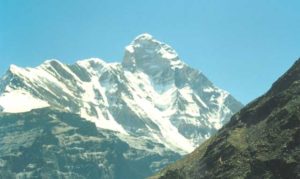
The Nanda Devi National Park is situated within Nanda Devi Biosphere Reserve in Chamoli district of Garhwal. NDNP is geomorphologically shaped like a bowl surrounded by high mountain ridges and peaks on all sides except its western side. NDNP is spread over an area of 624.6 Sq. Km. The National Park houses many rare and endangered flora and fauna characteristic of higher Himalayas. There are 16 gorgeous peaks above 6000 m. height and four of them are above 7000 m. height in and around NDNP.
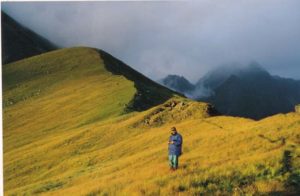
Goddess Nanda Devi, the reigning deity of Uttaranchal, lies in NDNP’s sanctum sanctorum and is held in great reverence throughout the State. Owing to its rich biodiversity, Nanda Devi was declared a Sanctuary in 1939. It was raised to the status of a National Park in 1982. Subsequently, in 1988 UNESCO declared NDNP as a World Heritage Site.
It’s opening up of Nanda Devi National Park, which has remained closed for all types of tourist activities since 1983, is for initiation of regulated trekking along a 9 km. Latakharak-Dharasi-Debrugeta trail and establishment of two camping sites at Dharasi and Dibrugeta of Uttaranchal Govt. letter no. 494/1(2)FRD/2003- 12(72)/2001, dated 05-04-2003 inside the park.
- Conservation significance-
![]() Prior to 1983 human activities, especially reckless mountaineering and trekking had done severe damage to the eco-system of NDNP. The Nanda Devi National Park was closed for general public since 1983 and has since remained closed for all types of visitors. The decisions of Government of India vide G.O. No. MHA U.O No. III 11039/ 82– G&O dated 02-04-1983 resulted in this ban. The ban was reiterated for another five years in 1994 by Govt. Order F.No. J-22016/40/94-BR dated 14-09-1994 by Ministry of Environment and Forests, Government of India. The ban period lapsed in the year 1999. The past decision of State and the Central the government which have regulated the management of NDNP. Regulated trekking along a 9 km. Latakharak-Dharasi-Debrugeta trail and establishment of two camping sites at Dharasi and Dibrugeta of Uttaranchal Govt. letter no. 494/1(2) FRD/2003- 12(72)/2001, dated 05-04-2003 inside the park.
Prior to 1983 human activities, especially reckless mountaineering and trekking had done severe damage to the eco-system of NDNP. The Nanda Devi National Park was closed for general public since 1983 and has since remained closed for all types of visitors. The decisions of Government of India vide G.O. No. MHA U.O No. III 11039/ 82– G&O dated 02-04-1983 resulted in this ban. The ban was reiterated for another five years in 1994 by Govt. Order F.No. J-22016/40/94-BR dated 14-09-1994 by Ministry of Environment and Forests, Government of India. The ban period lapsed in the year 1999. The past decision of State and the Central the government which have regulated the management of NDNP. Regulated trekking along a 9 km. Latakharak-Dharasi-Debrugeta trail and establishment of two camping sites at Dharasi and Dibrugeta of Uttaranchal Govt. letter no. 494/1(2) FRD/2003- 12(72)/2001, dated 05-04-2003 inside the park.
- Area description, climate and geography-
Coordinates
Nanda Devi National Park lies between 30o16′ to 30o32′ North longitude and 79o44′ to 80o02′ East latitude.
Boundary Description of Nanda Devi National Park made vide
Uttar Pradesh Govt.Order No.3912/14-3/35/ 80, dated – 6th Sept 1982
The boundary description of the Nanda Devi National Park is as under
Northern Boundary- From the confluence of Rishiganga and Dhauliganga Rivers and then running along the ridges of Dunagiri Peak, Changbang, Kalanka Peak upto the crest of the Rishi Pahar Peak.
Eastern Boundary- From the crest of Rishi Pahar Peak then running along the boundary between Chamoli and Pithoragarh district upto Nanda Devi East Peak and then up to the point where the boundaries of Pithoragarh , Almora and Chamoli district meet.
Southern Boundary- From the point where the boundary of Chamoli, Almora and Pithoragarh district meet and then running along the boundary of Chamoli and Almora District which passes through Nandakhat peak and Mrigthuni upto the point where inter district boundary turn suddenly to the south than run along the ridges of the mountain ranges up to the Nandaghunti Peak .
Western Boundary- From Nandughunti peak along the mountain range upto to Rewti Peak and then along Rewtigard River up to the confluence of Rishiganga and Rewtigard rivers and then further along Rishi ganga up to the point where Rishiganga meets Dhouliganga river .
Altitudinal Range
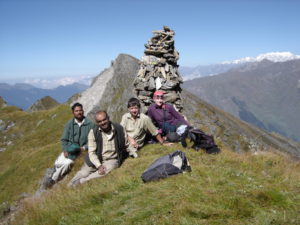
3,500m (the basin) to 7,817m (Nanda Devi West); the lower Rishi Gorge falls to 1,900m.
Climate
Being an inner Himalayan valley, Nanda Devi Basin has a distinctive microclimate. Conditions are generally dry with low annual precipitation, but there is heavy rainfall during the monsoon from late June to August. Prevailing mist and low cloud during the monsoon keeps the soil moist, hence the vegetation is lusher than is usual in the drier inner Himalayan valleys. The basin is usually snow-bound for six months between October and March, the snow accumulating deeper and at lower altitudes on the southern than on the northern side of the valley (Lavkumar, 1979; Lamba, 1987). Meteorological data are not available, but from April to June temperatures are temperate.
Most of the important snow peaks detailed below fall at the outer periphery of the Nanda Devi National Park. The details are as under-
| (a) Northern Boundary – | Dronagiri (7066 mt)
Chang bang (6864 mt) Kalanka (6931 mt) Rishi Pahad (6992 mt)
|
| (b) Eastern Boundary – | Magrun (6265 mt)
Deodamia (6032 mt) Bamchu (6302 mt) Damchu (6260 mt) Latu Dhura (6389 mt) Nanda Devi East (7434 mt) Nanda Devi Khal (5885 mt)
|
| (c) Southern Boundary – | Nandakhat (6545 mt)
Panwali Dhar (6663 mt) Sundar Dhunga Khal (5550 mt) Magtoli (6803 mt) Mrigthuni (6855 mt) Nanda Ghumti (6305 mt)
|
| (d) Western Boundary | Raunthi (6063 mt) |
- Maps-
- Flora, fauna & flagship species-
Main type of forests found in the Park area as follows:
(i) Upper temperate, (ii) Sub Alpine, (iii) Lower Alpine, (iv) Alpine, (v) Moraine,
(v) Perpetual glacier
Vegetation
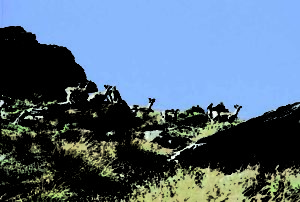
Forests are restricted largely to the Rishi Gorge and are dominated by fir Abies pindrow, rhododendron Rhododendron campanulatum and birch Betula utilis up to about 3,350m. Forming a broad belt between these and the alpine meadows is birch forest, with an understorey of rhododendron. Conditions are drier within the ‘Inner Sanctuary’, becoming almost xeric up the main Nanda Devi glaciers. Beyond Ramani, the vegetation switches from forest to dry alpine communities, with scrub juniper Juniperus pseudosabina becoming the dominant cover within the ‘Inner Sanctuary’. Juniper gives way attitudinally to grasses, prone mosses and lichens, and on riverine soils to annual herbs and dwarf willow Salix spp. Woody vegetation extends along the sides of the main glaciers before changing gradually to squat alpines and lichens. In all nearly 600 species of plants are known from the core zone (ie. the Nanda Devi National Park) of Nanda Devi Biosphere Reserve. Of these nearly 425 species are dicots, 173 monocots and rest are gymnosperms. In all more than 800 species of plant are reported from
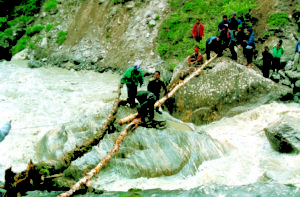
the NDBR area. Most of the areas of NDBR are too high to support any kind of plants growth. Below these lie the alpine and sub alpine grasslands locally called ‘bugyals’ The bugyals are free from snow for a brief period of 5 to 6 months in which the plants grow, flower, seed & die. These grassland support a wide variety of flowering plants suchas Potentillas, Geraniums, Andcosace, Primulas, Pedicularis, Cyananthus, Gentians, Morina etc. The bugyals are also rich in medicinal plants such as Orchis latifolia, Jurinea sp. Thalictrum Sp. Gaultheria sp. etc. Below the bugyals lie the sub-alpine forests of Birch (Betual utilis) and Rhododendron campanulatum. The temperate forests of broad leaves and conifers are found mainly in the Dhauliganga and Pindar valleys. The forests of the Pindar valley are moist and have an admixture of Spruce, Fir, Maples, Horse Chestnut, Walnut, Oaks etc. The Dhauliganga valley forests are dry and are dominated by Deodar and Blue Pine. The area between Suraithota and Malari contains very old over mature stands of Deodar which make the eastern limit of Deodar distribution in the world.
The various faunistic surveys in the park have resulted in the finding of the presence of 18 mammals. Seven of these are endangered. The important mammals are snow leopard (Panthera uncia) Black Bear (Celenarctos thibetanus) Brown Bear (Ursus arctos) Musk Deer (Moschus chrysogaster) Bharal (Pseudois nyaur), Himalayan Thar (Hemitragus jemlahicus), Serow (Captricornis sumatraensis) . Nearly 200 species of birds are reported from the biosphere reserve. The distribution of goral Nemorhaedus goral (LR) does not appear to extend to within the basin, although the species does occur in the vicinity of the national park (Tak and Lamba, 1985; Lamba, 1987). The only primate present is common langur Presbytis entellus (Tak and Lamba, 1985; Lamba, 1987) although Rhesus macaque Macaca mullata (LR) has been sighted outside the park boundaries (Sathyakumar, n.d.). The birds are of temperate, sub-alpine and alpine zone of Himalayas. Many of the birds species found in the area move down to lower altitudes in the lower Himalayas and foothill while a few migrate down even to the northern plains and
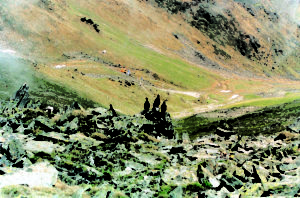
peninsular India in the winters. Abundant species recorded during May-June include crested black tit Parus melanolophus, Yellow-bellied fantail flycatcher Rhipidura hypoxantha, Orange flanked bush robin Erithacus cyanurus, Bluefronted redstart Phoenicurus frontalis, Indian tree pipit Anthus hodgsoni, Vinaceous breasted pipit A. roseatus, Common rosefinch Carpodacus erythrinus, and nutcracker Nucifraga caryocatactes. Species richness was found to be highest in temperate forests, with a significant decline in richness as elevation increased. Eight species of birds found in the area are endangered viz. Monal pheasant (Lophophorus impejanus), Koklas Pheasant (Pucrasie macrolopha), Western Tragopan (Tragopan melanocephala), Himalayan snowcock (Tetraogallus himalaysis) .Some 546 species are reported from the whole biosphere reserve area. 27 species of butterfly from 6 families during May-June 1993, including Common yellow swallowtail Papilo machaon, Common blue apollo Parnassius hardwickei, Dark clouded yellow Colias electo, Queen of Spain Issoria Iathonia, and Indian tortoiseshell Aglais cashmirensis have been recorded in the park. Some noteworthy features of the park are as under-
Eight most endangered and threatened birds of the park are Himalayan golden eagle (Aquila chrysactos daphancea), Eastern steppe eagle (Aquila rapax nipalensis) Black eagle (Ictinaetus malayensis perniger), Himalayan bearded vulture (Gypaetus barbatus), Himalayan snowcock (Tetragullus himalayensis himalayensis), Western tragopan (Tragopan melanocephalus), Himalayan Monal pheasant (Lophophorous impejanus), Koklas pheasant (Pucrasia macrolopha macrolopha).
- People of the landscape-
There is no human habitation inside the park area but outside park area inhabited people of Indo-Mangoloid and Indo-Aryan origin. Human population is dominated by Bhotia community, a schedule tribe. Bhotia living in Chamoli have two sub groups known as Toclha & Marcha. Each Bhotia group speaks its own dialect including Garhwali, Kumauni & Tibetans. Local people have adopted to the harsh climate and tough terrain of the area by having settlements at lower altitude while the summer settlements at higher altitude lying inside the buffer zone. Only three villages Reni, Paing, Suraithota are sedentary and nine villages viz; Muraina, Lata, Tolma, Segari, Phagti, Kaga, Garpak, Dunagiri and Malari are migratory.
- Visitor Information-
- Seasonality
The Park will remain open from 1st May and close on 31st October every year for a period of 6 months.
- How to reach
There are two approaches to reach in Nanda Devi National Park via Lata viz;
- Rishikesh-Srinagar-Joshimath-Tapovan-Lata (Approx. distance 289 Km.)
- Haldwani-Ranikhet-Karanpryag-Joshimath-Tapovan-Lata (Approx. distance 333 Km.)
- Zonation
The Latakharak-Dharasi-Dibrugeta trail lies in north eastern part of the tourism zone. This trek involves a high altitude 9 km. trekking route between 4000 m.-4380 m. The entrance and exit will be at Latakharak. Two new halting camp sites will be developed at Dharasi- 4 km. inside and Dibrugeta- 9 km. inside the Park.
- Entry gates
The entry inside the park will be only through village Lata. The following route will be followed-
1) Lata to Belta – 5 Km.
2) Belta to Latakharak – 4 Km.
3) Latakharak to Dharasi – 4 Km.
4) Dharasi to Dibrugeta – 5 Km.
Two alternative circuitous trek routes have been proposed for tourists while returning from Dibrugeta and Dharasi-
Route No. 1
Dibrugeta to Dharasi – 4 Km.
Dharasi to Jhandidhar – 3 Km.
Jhandidhar to Tolma – 5 Km.
Route No. 2
Dibrugeta to Latakharak – 4 Km.
Latakharak to Sainikharak – 5 Km.
Sainikharak to Peng – 4 Km.
Peng to Reni – 4 Km.
- Facilities and Accommodation
Forest Rest house with two suites is available at Joshimath. Electricity, Water and Kitchen facilities are available at these rest houses. Apart from Forest Rest House, Garhwal Mandal Vikas Nigam’s Tourist Rest House and many private hotels and Lodges are available at Joshimath. Ordinary food is also available in the Hotels and Lodges. Home stay facility is also available at Tolma and Reni Villages. There is small two room Forest hut is also available at Latakharak for night stay.
- Activities
Nature trails & trekking
No other activities except trekking for tourism purpose are allowed inside the park area.
- Rates and Tariffs
Eco fee & Camping fee for tourism inside Biosphere
Rules
Dos-
- Trekking will be permitted only on the designated trail along prescribed route.
- Camping will be permitted only on designated sites at Latakharak-Dharasi- Dibrugeta.
- Registered guide will be compulsory for a group of every five visitors or below.
- Declare all the items before park authorities at the time of entrance and exit the Park at Latakharak.
- Visitors only above 14 years of age will be allowed to go inside the park.
- Tourists will bring back all their generated waste during their stay inside the park and hand it over to the Park authorities at Latakharak.
Don’ts-
- Kindle fire; throw lighted Cigarette/Bidi butts or matchsticks inside the park.
- Destroy, trample, collect or remove any plant and animal specimen whether live or dead or any geological specimen.
- Carry instruments, implements, tools, arms, firearms or chemicals harmful to wildlife and vegetation.
- Shout, hoot, play audio and video tapes/radio inside the Park.
- Carry and introduce any animals or pets.
General directions for planning the visit-
- Trek for the park negotiates a steep assent at a high altitude zone within 13 km. route from 2000 m. at village Lata to 4250 m. at Dharasi- the topmost point. Visitors have to be physically tough for this trek.
- Get a thorough medical check up done before taking this arduous trek.
- Carry warm but light clothing, gloves, trekking shoes with good grip, rug sacs, sun glasses, and torch light, energy giving toffees- Do not carry too heavy a load.
- Carry common medicines for headache, stomachache, sprain and common cold etc and your own essential medicines.
- Nearby places of interest
| Place | Altitude (mt) | Distance (km) | Accommodation |
| Joshimath | 1890 | – | Hotels, Rest House, Camping ground |
| Auli | 2744 | 8 jeep | –“– |
| Gorson | 3658 | 7 trek | –“– |
| Tali | 3506 | 5 trek | –“– |
| Chitrakantha | 3506 | 4 trek | –“– |
| Gailgarh | 3658 | 3 trek | –“– |
| Kulari | 4266 | 5 trek | –“– |
- Contacts
1) Addl. Principles Chief Conservator of Forest/
Chief Wildlife Warden, Wildlife, Uttaranchal,
5 Chandrabani, Po.- Mohabewala, Dehradun.
Phone- 0135-2644691
2) Director/Conservator of Forest
Nanda Devi Biosphere Reserve, Gopeshwar
District- Chamoli.
Phone- 01372- 252497
3) Deputy Conservator of Forest
Nanda Devi National Park, Joshimath
District- Chamoli.
Phone- 01389-222179
- Threats & Problems-
- Constraints include extremely remote and rugged range, harsh climatic and environmental conditions that prevail in many areas. Funds for conservation and management of high altitude ungulate populations are becoming increasingly difficult to obtain. Specialized arms and cartridges suitable for high altitude are also required for the staff. In addition to this high altitude field survey equipment, four wheel driven high power petrol vehicles are also a must.
- A great challenge for the managers is the limited resources available to the native population of the region. These population which mostly occur at low to moderate densities, are primarily agro-pastoral. An important factor that needs to be considered is that the harsh Greater-Himalayan landscape is not used through out the year by people but the limited period for which they use it is not sustainable in nature. Arable land is mostly limited to alluvial fans, and some stable areas in the valley bottoms.
- The region has other peculiarities such as very poor road access, in adequate power supply and difficult communication, apart from a harsh climate during much of the year. These features of the region thus do not allow scope for conventional economic development and employment in the region as is possible in other regions of the country.
- A large number of wild animals are found outside existing PAs including Musk deer. According to an estimate 80% of wild animals may venture outside the PAs. Presence of animals such as the Blue Sheep, Serow, Black Beer, Musk deer, Goral occurring outside the PAs is quite common. Presence of wild animals out side PAs specially endangered animals like Goral, Thar, Musk deer, Serow put considerable management challenges to the park managers. Presence of wild animals particularly in the periphery is not only due to lack of prey animals and foraging site inside the park but due to sharp edge effects created by the villagers. As such habitat improvement inside as well as outside the park will have to be taken up .
- In the harsh environs of the region, there is a severe shortage of staff, effective infrastructure and funds for the management of the PAs. For example in Nanda Devi Biosphere Reserve there are only 28 Wildlife Guards to man an area of over 5000 sq. Km. especially so under the difficult climate and topographic conditions in the Greater-Himalayas. The numerous existing tasks of the wildlife Department range form protection, tourism management, verification of compensation claims to nature education activities in all the PAs spread all over the region. Most park staff lack the necessary clothing, equipment and housing necessary for effective work in the region.
- Bulk of the people of the region depends on cattle rearing. While some of the people are agro pasturelists, many are entirely pastoral. Livestock population in the Indian Greater-Himalayas has been growing continuously in the past decades and Uttaranchal is no exception. Even though conclusive information on habitat degradation and direct competition between domestic and wild herbivores from the region has not been documented yet the potential impacts of excessive grazing by livestock include depletion of the scarce forage for wildlife, habitat degradation, disease transfer and reduction in the breeding performance of both wildlife and domestic stock.
- In order to reduce pressure of live stock, grazing on pasture lands (Bugyals), fodder banks will have to be developed close to the villages. Near low altitude villages silvipastural system would have to be followed in which low density plantations of fodder trees along with grass will have to be raised. How ever, for higher altitude villages fodder development will have to be done by fencing of areas near village and enriching such patches with legumes wherever condition has deteriorated, Grass collection from these areas will have to be done under supervision of the village committee, prior to start of fire season. Proper record of fodder production and distribution will have to be maintained.
- Alpine pasture of the PA constitute prime habitat for endemic herbivorous population of the PA. The grasses found are Aconitum species, Primula species Potentilla spp, Fragaria spp. etc. These alpine pastures are also summer resorts for local grazers as well as nomadic Gujars. On account of heavy grazing pressure in some areas, “Rumex” and “Polygonam” weed has started colonizing.
- Even though fire incidences in the higher zones of Himalayas is not that frequent yet when caused by any reason, the Fire causes considerable damage to the Oak forests and all other vegetation of this zone. As such strict fire vigilance has to be maintained all the time.
- Annual census of high altitude elusive ungulate species is a specialized job and it can not be done in a routine way. Not only specialized equipments like light and powerful field glasses, cameras, are required but involving of technical staff and researchers are also a must. For proper maintenance of records and analysis of field data Computers and Statistical soft wares are also required. The technical staff and researchers from institutes like W.I.I will be engaged for training and technical support.
- The oak and fir forests hold special importance for mountain ungulates specially for Musk deer. As such their maintenance and management is a must. Some of the problems which these areas and also other lower elevation forests face are in adequate regeneration, soil erosion, slips, fire, over lopping, low water retention, steep un approachable slopes, over harnessing of medicinal herbs (in the buffer) etc.
- General perception of the local people about endangered species and their importance in the eco systems is poor. They do not accept that over all conservation of the eco-system ultimately contribute to sound footing for human survival and sustainable development. Attention is required to be focused to clarify the doubt apprehension of the local public at large. Efforts are also needed to high lighting biological and morphological importance of the PA in the context of human existence.
- Management Programme-
Thrust areas of management are as under-
- a) Habitat improvement works
Habitat improvement consists of bringing into useful association of those conditions needed by a species to reproduce and survive. Even creation of small openings is even of great value and importance. Such openings are essential for herbaceous cover and insect production on which ground living animals like pheasants predominantly feed during the first few weeks of life. Some of the works which will be conducted under this prescription are as under-
- Water replenishment
It is the most essential requirement for all wild animals. Presence of abundant food in a habitat is rendered useless, if water is not available in close proximity. The water hole areas will be selected using traditional knowledge about points of maximum concentration of animals and points where there used to be water sources which have now dried up. The water recharging pond locations will be selected by using local wisdom about presence of suitable water sources under soil rock formations. This will help to win local support for wildlife conservation. These water holes also serve a basic purpose of containing wild animals to the desired areas and not to go too near the human habitation so that they come in contact with domestic animals.
- b) Protection works
- Patrolling
In order to maintain the dynamic state of the ecosystem and to ensure that the evolutionary processes are not hampered, the natural systems should be least disturbed. The aim of protection activity is to preserve the genetic and species diversity of both the parks. More so the forest staff posted in the region are also legally duty bound to maintain strict vigil against any unlawful activity. Regular patrolling and maintenance of vigil are the core elements of protection works As such Long range and short range patrolling will be a regular feature of the management. Every month 2 short range and one long range patrolling will be carried out inside and peripheral region of the parks. A roster of these patrolling will be made in advance. In this patrolling activity local youths/EDC members/Ex-servicemen will also be associated and they will be given remuneration on daily work basis.
- Maintenance of secret fund
A secret method of intelligence will be developed involving all stakeholders and a secret fund will be kept to run this intelligence network. This is essential to provide incentives to the informers and to those who provide vital to the forest personnel in the field during actual raid operations.
iii. Fire protection and control
Fire is a good wildlife tool if used properly and judicially. But forest fires when break unwarranted do considerable harm. As such strict fire vigil has to maintain in the buffer and transition zones and warrant special vigil specially during the summer months in the lower zones and in the months of Oct- Nov and March to May in the higher zone.
- Immunization
In the high altitude grass lands near the villages situated in the close proximity of the both the park, the domestic cattle (specially sheep and goat) graze during summer months. Many wild herbivores that also come to these areas from the nearby core zone also graze on these areas. Spread of disease like foot and mouth disease from the domestic cattle to wild animals always loom large. As such regular immunization of the domestic animals is necessary.
- Strengthening of ant poaching camps and chaukies
The staffs that live in far flung remote areas need basic facilities like a safe and comfortable space to live in. Heavy rain and other vagaries of nature badly affect their quarters which are mostly situated in the higher reaches. As such these quarters call for annual maintenance. This activity is most important from the point of view of protection and regular patrolling activity.
- Legal support
Quick deterrent action in case of forest offence is very essential for keeping control over poachers and law breakers. However action in court requires funds. As such provisions have been made under this head.
vii. Arms and Ammunition and tranquilizing cartridges
All the field staff of both the parks has been provided with fire arms for self defense and for meeting any exigencies. As such provisions have been made under this head to buy ammunition and tranquilizing cartridges.
- c) Awareness & Training
Liaison with the community is essential as the health or condition of the environment is reflected by the manner in which we treat or manage it. Increasing awareness of what biodiversity is pressures that impact upon it, its intimate and essential connection to human survival and ways in which everyone can play a role in conservation is a necessary component for future conservation of biodiversity. These awareness programmes therefore will be taken up for the following purposes.
- To identify, establish and develop a process by which the staff of the department can understand the new paradigm of forestry and can be motivated to increase his own skill and knowledge.
- To increasingly involve people in and around P.A s into conservation planning and management of the area.
- To raise the level of awareness among the local community for the value and conservation needs of the protected area and patterns of economic growth and development which are locally appropriate and environmentally sustainable.
- To build the capacity of the community (specially of the women and youth) for self employment using the local natural resource (of the buffer area) and methods which do not jeopardize ecological sustainability.
- To actively involve the students and teachers in the nature conservation programmes and for dissemination of knowledge and awareness about conservation of flora and fauna of the park.
- d) Research and Monitoring
World Heritage listing of Nanda Devi National Park and application for inscription of Nanda Devi Biosphere Reserve as whole in the World list of Biosphere Reserve brings with it the obligation to monitor and research the condition of a listed property. The results of research and surveys in the Reserve provide baseline information about natural and cultural resources and visitors’ use of the Reserve against which the state of the environment can be gauged in regular monitoring programs. Flora and fauna and habitats need to be monitored over the long term for a complete understanding of the factors influencing the abundance and distribution of fauna. Flora and fauna monitoring in the Reserve provides useful information for regional conservation programs, local people’s enterprises, and the eco- tourism.
- Census
Regular animal abundance survey is an essential part of the management and as such this activity will be taken up in the parks.
- e) Communication and networking
The following steps will be taken to strengthen the communication and networking in the Reserve.
- Surface communication development
For enforcing surface communication the first requirement is mobility of the field staff and as such 4 motor cycles for the staff (two each for both the National Parks) and one diesel jeeps with large body for Range Officer of Nanda Devi NP and one Patrol Geep for the Dypt. Director of the Nanda Devi NP Forest Division are essential.
- Wireless communication development
In the rugged terrain of NDNP, wireless communication is a very effective and fast means of communication. The basic equipments for setting up of base stations and hand sets have already been bought.
- f) Conflict management
The basic aim of this activity is to keep the man animal conflict in control. Cattle lifting or loss of human life due to wild animal man conflict pose a serious threat to the life of the malignant animal. People will be educated about the traditional and institutional mechanism of reduction of conflict. Documentation of such practices will also be done. However despite all preventive measures, cattle lifting cases do take place and as such payment of ex-gratia payment will be made to the victims to reduce conflict as quickly as possible.
- g) Trek route maintenance and development.
Creation of National Park have also affected the livelihood opportunities of the locals which used to come way of serving as guides and porters in mountaineering and trekking activity inside the park. Therefore the avenues for alternate livelihood support had to be explored. Development of trek routes and Nature trails facilitate patrolling of the forest department on one hand and on the other hand it enables the local population to enhance nature based tourism in the area which is coming up as an important source of livelihood support activity in the buffer areas.
- Funding pattern-
Funds provided for the management of national park under centrally sponsored scheme Development of national park & sanctuaries annually-
- Organisational structure-
Addl. PCCF, Wildlife, Uttaranchal
CF/Director, Nanda Devi Biosphere Reserve, Gopeshwar
DFO, Nanda Devi National Park, Joshimath
SDO, Nanda Devi National Park, Joshimath
RO, Joshimath Range
AWLW/Forester, Reni Section, Joshimath Range
WLG/Forest Guards, Reni Section, Joshimath Range
- Innovative approaches-
Purchase and distribution of locally produced raw wool & establishment of wool carding and finishing plants.
Prior to creation of Nanda Devi NP in 1982 the people residing in the areas surrounding the National Park traditionally used to graze their cattle in the park area. Besides they used to collect and sell NTFP like Gucchi (Morchella) and medicinal plants which they were enjoying by way of traditional rights. The mountaineers and trekkers used to visit the area that employed local people living in the surrounding buffer zone as guides and potters. Besides they used to keep large herds of sheep which have also suffered due closer of free grazing areas. The main occupation of the local people is goat and sheep rearing. Goats are kept for meat and for transportation of essential commodities to such far flung areas where there are no motor roads or bridal paths. Sheep are reared for wool and meat. Wool is used for making woolen clothes. In order to increase their income and keep this livelihood activity going, the wool industry has to be encouraged. For the past few years free distribution of wool is being practiced. In the year 2001-2002 a carding machine for raw wool has been setup at Lata. Women’s Welfare Group of Lata village has been actively involved in the management of this Carding Plant and they have been made responsible for running and maintenance of the machine. The rate fixed by District Magistrate Chamoli. The beneficiaries for free distribution of wool will be only those families from the villages of Buffer and transition zone who are actually involved in this activity. Domestic weaving and thread making machines had already been distributed in villages of buffer and transition zone in the year 2003-04. This is a great help to local inhabitants for the upliftment and information of livelihood of activities. It also developed cordial relationship among local inhabitants and park authorities.
- Perception of the future-
The measure threat to Nanda Devi NP is continuing pressure on Government to open up this area park mountaineering and trekking activities. It should continue to remain in violet as it is extremely crucial for the long term conservation of the park, A World Heritage Site. It has great potential not only as Himalayan Biodiversity rich area but also for serving as a control area to compare the status of Wildlife and habitats in other parts of the Himalaya that are subjected to varied levels of human use.
- Important references-
Landscape plan of Nanda Devi Biosphere Reserve, the Management Plan of Nanda Devi National Park and Biodiversity Monitoring Expedition (Nanda Devi 2003).
royel capture
royel view
Uttrakhand is simply unexplored heaven in india
Thanks for the information?????
The Nanda Devi National Park is also the home of Bhotiya tribal community who consider Nanda Devi as the patron Goddess of the region. Since the Nanda Devi region is popular for its physical and natural landscape, the resident of village Lata, gateway to the park, are now offering an Interpretative Trek to the Nanda Devi National Park with an aim to create an all immersive experience for the visitors. The bookings for the summer 2019 trekking season are now open
#nandadevinationalpark